Biodiversity
Basic Approach
The operations of the ENEOS Group may impact the environment surrounding our operation and production sites. Given the nature of our business, we consider biodiversity conservation to be an important effort, as stated in the ENEOS Group Code of Conduct.
We carry out initiatives with attention to biodiversity in our business activities. These initiatives include the implementation of environmental impact studies when establishing new operation and production sites in order to obtain an accurate understanding of local ecosystems, including plants, birds and other animals, and marine life.
In addition, ENEOS, which has many production sites, has established the Energy Group* Guidelines on Biodiversity.
Energy Group*Guidelines on Biodiversity
Basic Stance
We will carry out initiatives with attention to biodiversity in every aspect of our business activities, under the recognition that our business activities are deeply related to the Earth’s biodiversity.
Action Policy
- 1.We will ascertain and analyze the impacts of our business activities on biodiversity and strive to make improvements.
- 2.We will promote activities that contribute to biodiversity preservation, such as nature protection and environmental education.
- 3.We will disclose and share information on our efforts to preserve biodiversity.
- *ENEOS and its Group companies
Structure
For information on our structure, see Environmental Management.
Material Issues, Plans and Results
Understanding Biodiversity Risks
The Group has identified biodiversity risks as a material ESG issue and worked toward the target “understanding risks at manufacturing sites” in fiscal 2022. We utilize the Integrated Biodiversity Assessment Tool (IBAT), available to the general public, to understand risks at our manufacturing sites. Thus far, we have investigated the risks at a total of 27 sites1, including overseas sites. As a result, we have verified that there are no protected areas within a five-kilometer radius of our manufacturing sites that fall under the categories of strict nature reserve, wilderness area, national park, or natural monument or feature (see table below for categories Ⅰa, Ⅰb, Ⅱ, and Ⅲ).
We will review the results of risk assessments every three years. In addition, in the event that new protected or conservation areas are identified due to the expansion of a site or other factors, we will obtain detailed information from external organizations and assess the impacts on our operations.
The results of these efforts are reported to the Executive Council and the Board of Directors at least once a year.
In fiscal 2023, we explored further identifying risks at our manufacturing sites and decided to work on “understand the degree of dependence and impact on natural capital.” To this end, in fiscal 2024, we plan to conduct a survey of our main business sectors using ENCORE2, an online tool available to the general public.
- 1ENEOS: 17 (11 in Japan, 6 overseas), ENEOS Xplora: 3 (1 in Japan, 2 overseas), and JX Advanced Metals: 7 (6 in Japan, 1 overseas).
- 2Exploring Natural Capital Opportunities, Risks and Exposure: A tool to help organizations investigate their exposure to nature-related risks and understand their dependencies and impacts on nature.
International Union for Conservation of Nature (IUCN) Protected Area Categories
| CategoryⅠa CategoryⅠb |
Strict nature reserve Wilderness area |
Protected areas that are managed for academic research or protection of wilderness |
| Category Ⅱ | National park | Areas managed for protection of functioning ecosystems and recreation |
| Category Ⅲ | Natural monument or feature | Areas managed for protection of special natural features |
| Category Ⅳ | Habitat/species management area | Areas managed for conservation by additional management |
| Category Ⅴ | Protected landscape or seascape | Areas managed for landscape protection and recreation |
| Category Ⅵ | Protected area with sustainable use of natural resources | Areas managed for sustainable use of natural ecosystems |
Major Initiatives
Participation in Initiatives
Endorsement of the Declaration of Biodiversity by Keidanren
ENEOS Holdings endorses the Declaration of Biodiversity by Keidanren, which states the aim of “building a society in harmony with nature and realizing a sustainable economy and society.”
Participation in the Japan Business Initiative for Biodiversity (JBIB)

ENEOS has been a member of the Japan Business Initiative for Biodiversity (JBIB), a consortium of businesses actively working to conserve biodiversity in Japan, since 2013.
Participation in Call to Action
In December 2020, ENEOS Holdings joined the Call to Action of the global coalition Business for Nature*.
The Call to Action calls on governments around the world to adopt ambitious policies to reverse nature loss in the decade up to 2030, under the concept that “healthy societies, resilient economies, and thriving businesses rely on nature,” with many enterprises around the world having declared their support to date.
- *Spearheaded by organizations such as the World Economic Forum, the World Business Council for Sustainable Development and the International Chamber of Commerce, Business for Nature is a global coalition established with the aim of encouraging businesses to take action toward nature conservation and restoration and drawing on businesses’ aspirations for nature conservation and restoration to influence policy decision makers.
Participation in the 30by30 Alliance for Biodiversity

In April 2022, ENEOS Holdings joined the 30by30 Alliance for Biodiversity.
The 30by30 Alliance is a voluntary alliance launched in April 2022 by 17 organizations representing the industrial, private, and governmental sectors, including the Ministry of the Environment. Its objective is to reach the 30by30 target for Japan, which aims to conserve or protect 30% of land and sea areas by 2030, one of the proposed targets in the first draft of the post-2020 Global Biodiversity Framework.
In October 2023, the central greenbelt of the Negishi Refinery, one of the Group’s manufacturing sites, was certified as a Nationally Certified Sustainably Managed Natural Site*, a Ministry of the Environment certification system for achieving the 30by30 target.
- *A new system that began in fiscal 2023 to recognize areas where the Ministry of the Environment certifies that “biodiversity is being conserved through private sector initiatives,” as the 30by30 target cannot be achieved solely through the inclusion of protected areas such as national parks.
Major Initiatives in Japan
The Group carries out activities at its manufacturing sites for the conservation of vibrant biodiversity as one way of participating in community efforts to protect biodiversity and maintaining ecosystem networks in large green areas around the sites. At our other business sites as well, we carry out environmental conservation activities suited to the surrounding environments.
We also carry out activities such as regular environmental training for employees and community contribution activities related to environmental conservation.
Status of Certifications Related to Biodiversity
| Type | Scope | Acquired |
|---|---|---|
| ABINC certification1 | Central greenbelt at ENEOS Negishi Refinery | February 2020 |
| Nationally Certified Sustainably Managed Natural Site certification by the Ministry of the Environment | Central greenbelt at ENEOS Negishi Refinery | October 2023 |
| OECM2 registration | Central greenbelt at ENEOS Negishi Refinery | August 2024 |
Green Area Management: Initiatives at the ENEOS Negishi Refinery
The ENEOS Negishi Refinery is one of Japan’s largest oil refineries, with an area of 2.2 million square meters and a circumference of around 12 kilometers. The area in which it is located has a network of ecosystems with a diverse array of organisms inhabiting an expansive greenbelt that includes Sankei-en and Negishi Forest Park. The Negishi Refinery carries out activities for the conservation of biodiversity utilizing the greenbelt (approximately 60,000 square meters), a hub for the area’s ecosystem network, at the center of the premises.
Ecosystem surveys were begun in fiscal 2013, and in surveys to date, the presence of over 150 types of living organisms has been confirmed.
In fiscal 2018, we began holding interactive events and using goat grazing to weed the greenbelt areas, further enhancing these areas with the expansion of these efforts. Since fiscal 2019, we have been stepping up maintenance and management of the green areas.
The Negishi Refinery was granted certification by ABINC1 in February 2020. The refinery was certified as a Nationally Certified Sustainably Managed Natural Site in October 2023 and registered as an Other Effective area-based Conservation Measures (OECM2) site in August 2024.
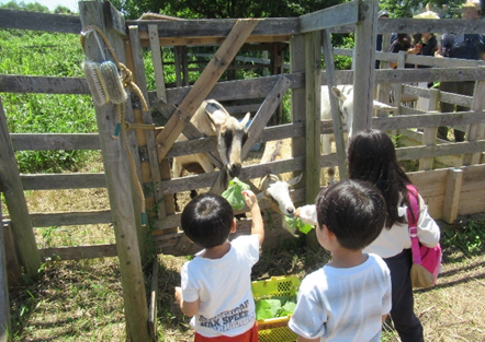
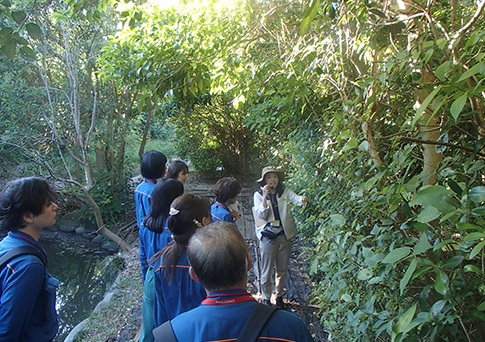

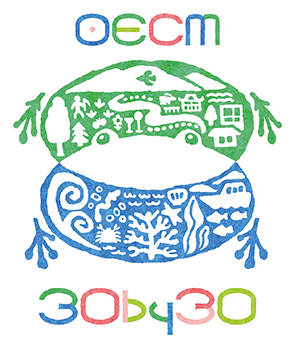
- 1ABINC certification is awarded on the basis of the JBIB Guidelines for Sustainable Business Sites and the JBIB Land Use Scorecard developed by the Japan Business Initiative for Biodiversity (JBIB).
- 2Other Effective area-based Conservation Measures: Areas other than protected areas such as national parks that contribute to biodiversity conservation. The areas certified as “Nationally Certified Sustainably Managed Natural Sites” are registered in the international database as “OECMs,” except when overlapping with protected areas.
Seaweed Bed Creation: Initiative at the ENEOS Sakai Refinery
The ENEOS Sakai Refinery is located in the Sakai-Semboku Coastal Industrial Zone in the inner part of Osaka Bay. Osaka Bay is an enclosed sea area, and the inner part of the bay has a water quality that makes it difficult for living things to thrive, as nutrients such as nitrogen and phosphorus flowing in from the land tend to stagnate, resulting in red tides.
In fiscal 2022, the refinery began working to create seaweed beds along its coastal area so that a variety of creatures can live in the waters. By creating seaweed beds, we can expect multi-dimensional effects such as improving water quality through the absorption of nutrients and the supply of oxygen, increasing places for the spawning and growth of marine life, and accumulating blue carbon through the photosynthesis of algae.
In 2024, the refinery joined the Members of the Osaka bay Blue carbon ecosystem Alliance (MOBA) (established by Osaka and Hyogo prefectures) and will continue working with neighboring organizations to advance this activity.
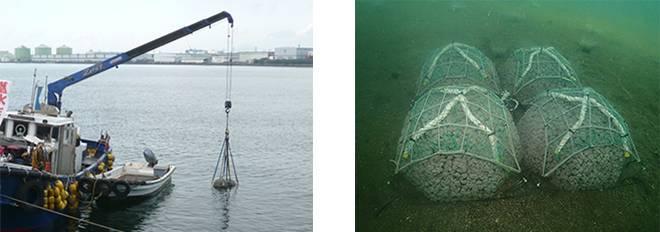
Forest Stewardship and Afforestation Activities
Group companies are involved in forest stewardship activities that contribute to the preservation of biodiversity.
ENEOS implements forest stewardship activities called ENEOS-no-Mori at six locations across Japan in partnership with local governments and the National Land Afforestation Promotion Organization (NALAPO).
Since 1998, ENEOS Xplora has implemented a forest stewardship project called ENEOS Xplora Nakajo Forest on and around the site of its Nakajo Field Office in Niigata Prefecture.
JX Advanced Metals is working to maintain and improve the natural environment by continually engaging in afforestation activities such as tree planting and thinning, mainly at the sites of its closed mines.
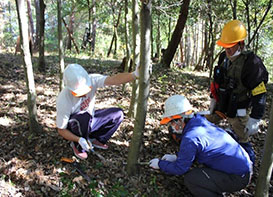
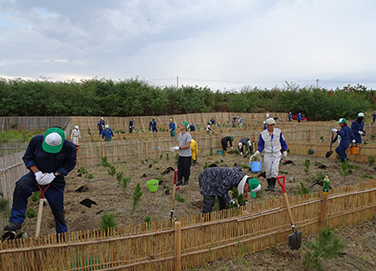
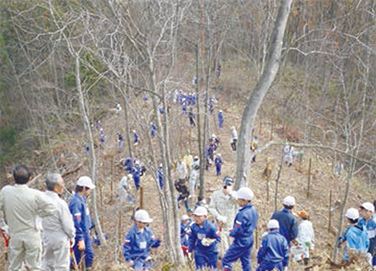
Initiatives at Closed Mines
The JX Advanced Metals Group believes that there is great potential to contribute to the conservation and restoration of biodiversity through the appropriate management of its closed mines as ecosystems. Most of the closed mines are forested areas, which play a part in the function of local ecosystems as water source cultivation and habitats for flora and fauna.
The group has therefore begun to assess the ecosystems of the watersheds where its closed mines are located. Going forward, after formulating an ecosystem management plan that systematically outlines the ecosystems to be achieved at its closed mines and the efforts to be made toward that end, it will begin full-scale management of the ecosystems at these closed mines.
In fiscal 2023, the JX Advanced Metals Group assessed its closed mines in terms of biodiversity and selected the Hitachi Mine and Yoshino Mine as model sites based on assessment results and other factors. At both mines, it conducted environmental DNA surveys* to understand the fish fauna in the watersheds in which the mines are located.
- *Environmental DNA: A designation for in vitro DNA released from fish, amphibians, birds, and mammals.
Environmental DNA survey method: Extraction and detection of environmental DNA from water collected at the applicable sites. Detection methods can be broadly classified into those that target only a single species and those that detect specific taxonomic groups (e.g., fish) collectively.
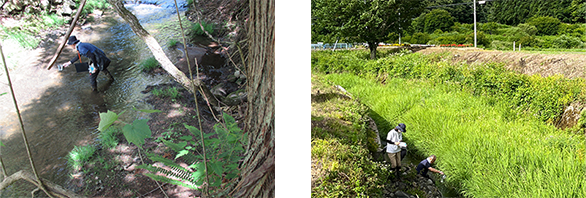
Providing Sustainable Seafood Menu Options at the Employee Cafeteria
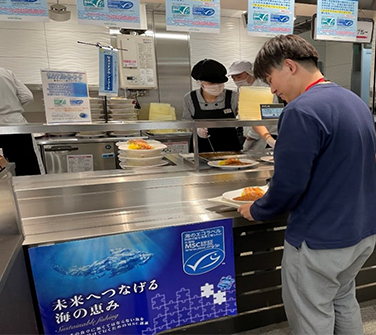
Since 2019, the Company has been offering sustainable seafood* menu options once a month at the ENEOS Building employee cafeteria, used by the Company and its Group companies. In 2020, we began offering sustainable seafood menus at the employee cafeterias of some of our refineries.
Through this initiative, we are working to raise awareness about biodiversity conservation and environmental conservation among Group employees through food, a part of everyday life.
- *The seafood has met the MSC’s global standard for sustainability or ASC’s global standard for responsibly farmed seafood.


Major Initiatives Overseas
Measures for Ballast Water (Seawater)
Oil tankers from Japan bound for oil-producing countries carry ballast water (seawater) as weight to maintain stability for unloaded voyages. However, this ballast water contains microorganisms and plankton from Japanese waters that are carried to the waters of oil-producing countries, where, if released, they can disturb the balance of local ecosystems.
Since 2004, the Group has replaced this ballast water while still at sea, and installed water treatment systems* for ballast water on its new vessels in an effort to avoid disturbing the ecosystems of the coastal waters of oil-producing countries. In fiscal 2022, we completed installation of ballast water treatment systems on all of the Group’s 15 tankers.
Furthermore, we release ballast water from ships using methods compliant with international treaties.
- *Systems that keep the level of aquatic organisms in ballast water within certain standards prior to release.